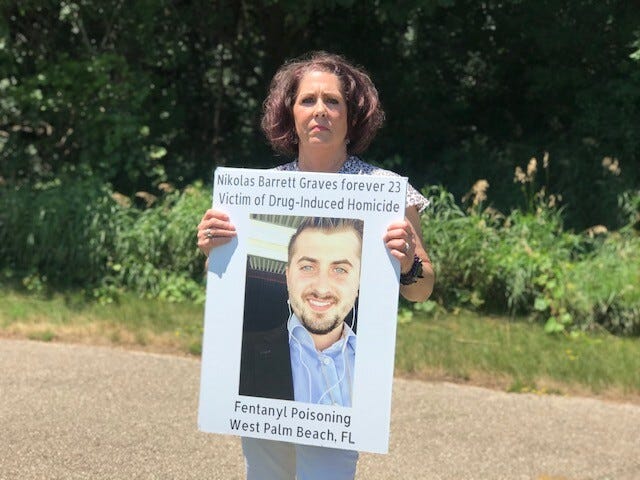🙏Girard, Scapegoats and Bad Drug Laws

Let justice roll down like waters.
Amos 5:24
Dear Friends and Colleagues,
The desire for revenge has deep roots.
When the people we love are hurt, we want to find someone or something to blame. This drive, philosopher, and historian René Girard argued, is so deep that we will always find someone to blame, whether they were responsible or not: the scapegoat.
Girard argued that this “scapegoat mechanism” was universal to human society and at the heart of our early religious impulses. Even though the “scapegoat” may not have been responsible for the conflict and the harm, the rest of the group becomes united in their desire for revenge through violence and exclusion.
While the scapegoat mechanism fails to address the underlying source of conflict, it does provide a temporary sense of peace for the dominant group. That is, for as long as that group continues to believe the lie that they have found the true perpetrator.
To maintain the illusion, the dominant group must ensure that their narrative is unquestioned and erase the story and perspective of their victims.
The scapegoat mechanism, and its suppression of the victim’s story, is on full display in the move towards “drug-induced homicide laws.”
25 states have some form of drug-induced homicide laws that allow for murder charges resulting from the crime of delivering or possessing drugs that result in death.
Proponents of the law argue that they help deter drug dealing and create harsher sentences for those who sell potentially lethal substances.
In reality, they do nothing to decrease drug-related deaths and may exacerbate other related harms. They are a form of revenge that ignores the true reasons why people overdose. In short, they are Girard’s scapegoat mechanism at work in our legal system.
To expose the scapegoat mechanism for what it is, we need to hear the stories of those being scapegoated.
When Morgan Godvin was 23 years old, she and her high school friend Justin were both addicted to heroin.
One night, Justin contacted her and asked if she had any heroin he could buy. While she didn’t often have more than one day’s supply, she did that day, and he came by to pick up a gram of the drug and then left.
The next day, he texted asking her for more. She replied that she still had some and that he could come over to pick it up. The next thing she knew, the SWAT team came bursting through her front door.
Her friend Justin had died of an overdose the night before. She had been texting with an officer. They arrested her on drug-induced homicide charges.
Justin’s family asked for leniency, but Morgan still served time in Federal prison. (Hear Morgan’s story in her own words here.)
Morgan also notes, and we explore in more detail below, there is no evidence that these laws save lives. And we have good reason to believe they may cost people their lives.
Imagine a scenario where two friends are using drugs together. Friend A picks up the drugs on the way to Friend B’s house and gets paid back once they arrive.
Friend B begins to overdose. Good Samaritan laws will protect Friend A if they call an ambulance. Drug-induced homicide laws could mean Friend A faces decades in prison if Friend B doesn’t survive.
The ultimate cause of overdoses is not low-level drug dealers or friends who share drugs. Drug-induced homicide laws may create a feeling of “doing something” when in reality, they are a scapegoat mechanism that only perpetuates a cycle of harm and violence.
Girard argued that one subversive aspect of the story of Jesus was that it broke the power of the scapegoat mechanism by telling the story from the perspective of the victim. Instead of the community benefiting through crucifying a scapegoat, Christ became the ultimate scapegoat and exposed the lies of the violent cycle.
If you have or know of a story that demonstrates the failed moral logic of the War on Drugs, let us know. There is power in the stories we choose to tell.
Keep the faith,
Timothy McMahan King
Senior Fellow, CNDP
News Round-up researched and compiled by
Cassidy Willard, Research Associate- CNDP

Image Source: www.texastribune.org
On March 15, 2023, the Texas Senate unanimously passed a bill, SB 645, that would charge the manufacturing or delivering of fentanyl as murder, if someone dies from an overdose.
The bill “would also stiffen penalties for making, delivering or possessing larger quantities of fentanyl. Having between 200 and 400 grams would be a first-degree felony, which could lead to between 10 years and life in prison as well as a fine of up to $100,000. Having more than 400 grams would also be a first-degree felony punishable by at least 15 years in prison and a fine of up to $250,000.”
The legislation will now move to the Texas house.
SB 645 will do nothing to reduce overdoses instead it will perpetuate racial injustice and exacerbate the harms of the war on drugs

Image source: www.pdaps.org
Drug-induced homicide refers to the crime of delivering or possessing drugs that result in a death. Today, 25 states and the federal government have drug-induced homicide laws. Many of these laws grew out of the War on Drugs in the 1980s. For many years the law were rarely used. However, today, the increasing rates of overdose deaths combined with political pressure has resulted in a revival of drug-induced homicide prosecution.

Image Source: www.drugpolicy.org
Drug Policy Alliance has detailed four main reasons drug-induced homicide laws are misguided.
#1: They do not deter drug use or sales.
“In 2011, for instance, researchers found that “[c]hanges in hard drug arrest rates did not predict changes in [injection drug use] population rates.” A recent 50-state study also found no relationship between state drug imprisonment rates and drug use or overdose deaths. In addition, the Office for National Drug Control Policy has found that, despite the increase in sentences and sentence severity for drug-related crimes, the rates of current use of controlled substances has continued to increase among Americans age 12 and older, from 6.7% reporting use in 1990 to 9.2% in 2012.”
#2: They undermine 911 Good Samaritan laws and contribute to preventable deaths
“Unfortunately, the only behavior actually deterred by drug- induced homicide laws is the seeking of life-saving medical assistance. The most common reason people cite for not calling 911 is fear of police involvement. A 1997-2000 San Francisco survey of 709 young injection drug users reported that only 53% of those who witnessed an overdose sought medical help upon doing so.”
#3: They foster misuse and prosecutorial discretion
“Because prosecutors need to prove that a defendant “caused” the death of the person who overdosed, charges become more difficult the higher up the distribution chain one goes. As a result, the cases that are charged are usually against the last person to touch the drugs prior to their ingestion – that is, the lowest person in the hierarchy of the distribution chain of command, and sometimes a person who had no intention to sell at all, but was merely sharing drugs or simply the last person to see the deceased alive.”
#4: They exacerbate racial disparities
“Although rates of reported drug use do not differ substantially among people of different races and ethnicities, black people are far more likely to be criminalized for drug possession and use than white people. African Americans experience discrimination at every stage of the criminal justice system and are more likely to be stopped, searched, arrested, convicted, harshly sentenced and saddled with a criminal record. These dynamics have clear outcomes. Black people comprise 13% of the U.S. population. But black people comprise 29% of those arrested for drug law violations, nearly 35% of those incarcerated in state or federal prison for any drug law violations, and roughly 35% of those incarcerated in state prison for possession only.”

Image Source: www.tmj4.com
Wisconsin provides a prime example of why drug-induced homicide laws are misguided and inhumane. In Wisconsin, anyone accused of causing the death of another person by providing or selling drugs is charged with reckless homicide, a class C felony. Prosecutions for drug-induced homicides have compounded over the past 20 years in Wisconsin. In 2008 just 43 people were prosecuted for drug-induced homicide compared to 680 people being prosecuted in 2018. Today, Wisconsin is third in the country for drug-induced homicide prosecutions.
According to Jeremiah Goulka, a senior fellow at Northeastern University School of Law, Health in Justice Action “[a] major concern he is seeing is that a disproportionate number of minorities are being prosecuted. . . Goulka says about 50 percent of cases involve a person of color being charged.” Yet, only 13 percent of the population in Wisconsin is a minority.

One of the people currently being prosecuted for drug-induced homicide in Wisconsin is a 15-year old who is being prosecuted for selling a blue fentanyl pill to an 18-year old who died from an overdose.
“The girl, who is four feet tall and 100 pounds, lived with her grandmother and shared a room with her sister, according to police reports. She said she worked a housekeeping job after school and wasn’t usually out late at night because her grandmother wanted her home… The girl said she was selling the pills in part to pay off a $500 drug debt she had racked up from smoking weed and “perks.” She said she was introduced to the man who provided her the pills by a male friend.”
As of right now, the 15-year old is facing up to 40 years in prison for first-degree homicide.
Drug-induced homicide laws do not end overdose deaths. Instead, they are counterproductive, inhuman, and archaic.

Drug-induced homicide laws won't end overdose deaths. Texans need public health tools NOW.
We must join with Texas Harm Reduction Alliance to stand against SB 645.
Sign the petition now.


